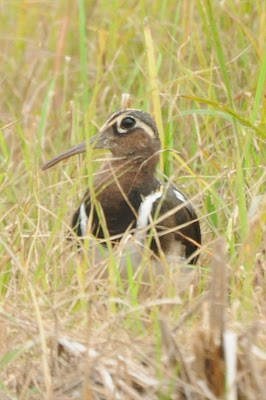First, though, we scoured the area for rails, birds that are becoming easier and easier to see. Buff-banded Rails (Gallirallus philippensis), life birds for Mark, are becoming positively abundant at Chupak (though the published guides still insist that they are rare vagrants in Sarawak); they seemed to be all over the place.
Migrant shorebirds were in unusually short supply, though we did see several Oriental Pratincoles (Glareola maldivarum), an unusual bird for Chupak, and numbers of Pacific Golden Plovers (Pluvialis fulva) - subtly handsome even in non-breeding plumage, as I hope this picture shows.
The bird of the day, encountered in late afternoon around one of the few padi fields that still held water, was the Greater Painted Snipe (Rostratula benghalensis). It had been years since I last saw one, and I have never been on such close terms with the species - perhaps because it was late afternoon, and these normally crepuscular birds were getting organized for their evening activities. We saw nine in all - one group of three pairs, another pair and an isolated male. This female, our first, sat only a few metres from Daniel's car.
They don't fly much, so this shot is a bit of a rarity. Painted Snipe are not, despite their name and general appearance, snipe. They are not even sandpipers, the family to which the true snipe belong. Instead, they are placed in their own family, Rostratulidae. Their closest relatives are probably the equally strange, but quite different-looking, jacanas (Jacanidae).
My friends were unaware of one of the oddest things about Painted Snipe, and were quite astonished when I told them about it: the more colourful and strikingly marked sex is the female, one of the few cases of reverse sexual dimorphism in birds.
The male, though, is handsome enough.
The real virtue of the Painted Snipe's plumage - and especially that of the male - is its ability to camouflage its wearer. Once the birds settled down among the dry stalks of rice, they simply vanished - even at close range. Notice how even the buffy stripe through the centre of the crown breaks up the bird's outline - it looks like just another dried stalk in the field.
Here are two more views of a wading male. It had a distinctive bobbing gait, quite unlike that of a true snipe.
Here, photographed in the light of late afternoon (plus flash), are the two sexes - the female in front, the male in back. Greater Painted Snipe rae usually polyandrous, each female mating with more than one male, but they can be monogamous at times. Perhaps these birds are a genuine couple?
On our way home we spotted another camouflage expert - a Cinnamon Bittern (Ixobrychus cinnamomeus), doing its level best to imitate a piece of wood. It seemed to work - a house cat, obviously on the prowl, walked right past it at close range, without, apparently, even noticing that it was there!





















No comments:
Post a Comment